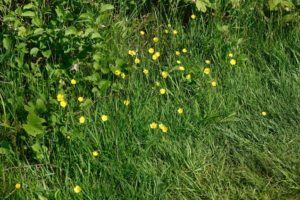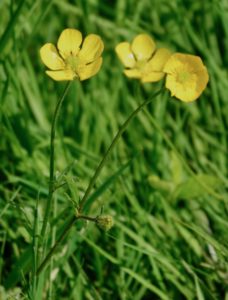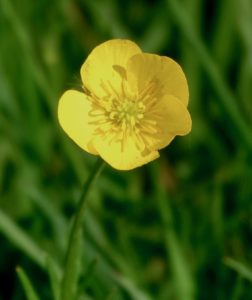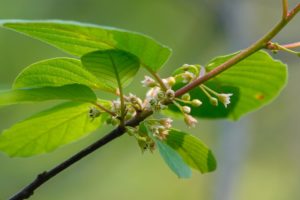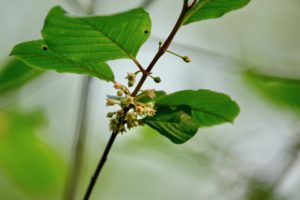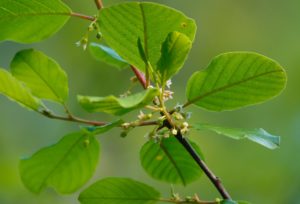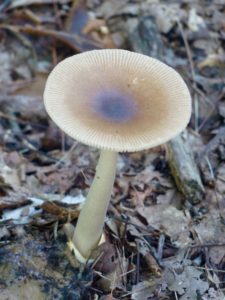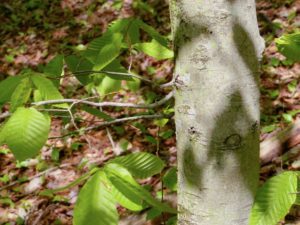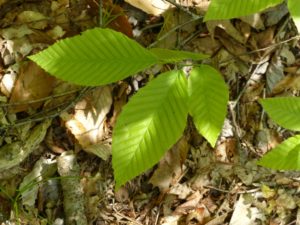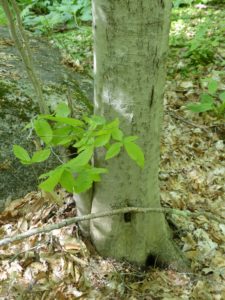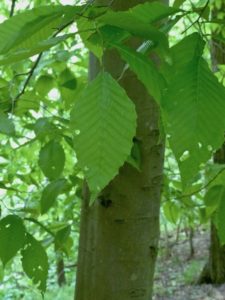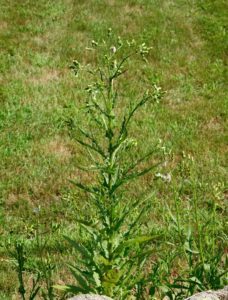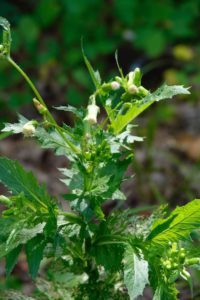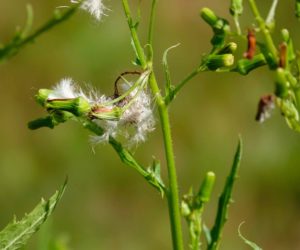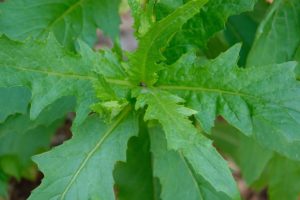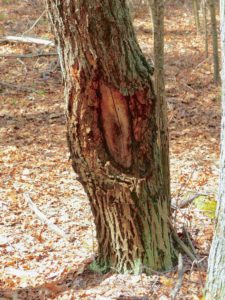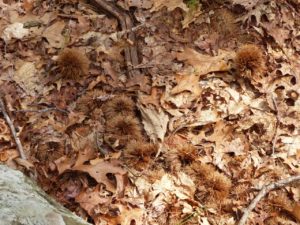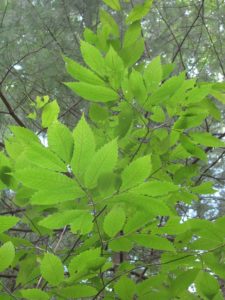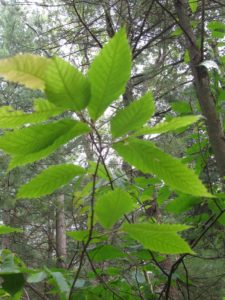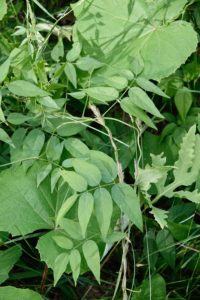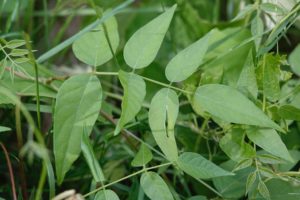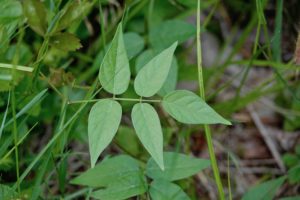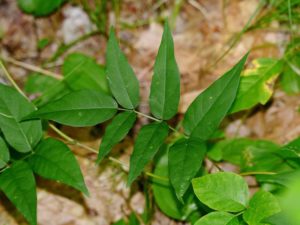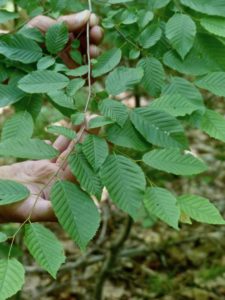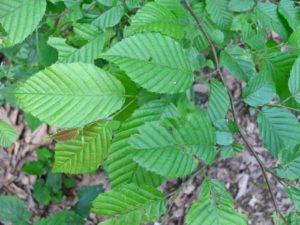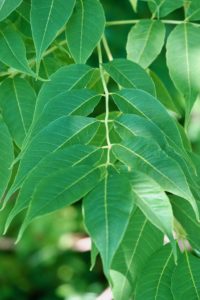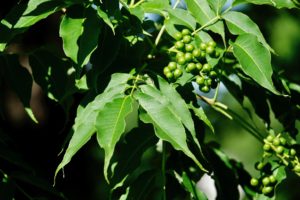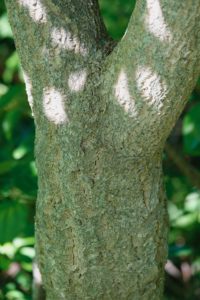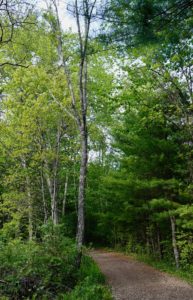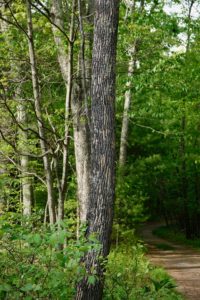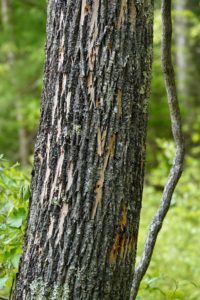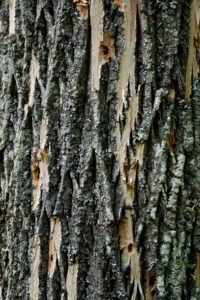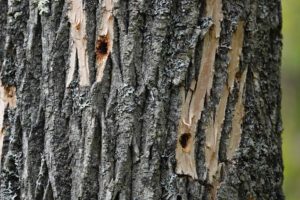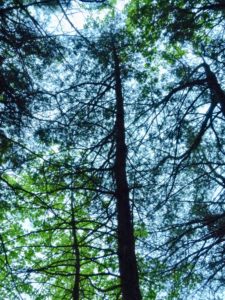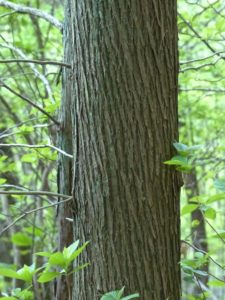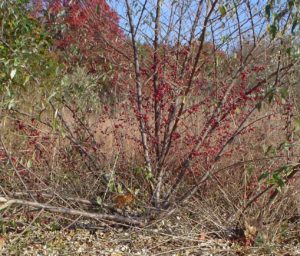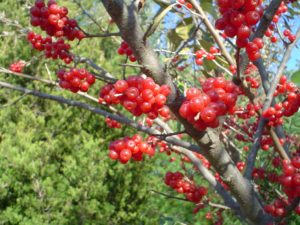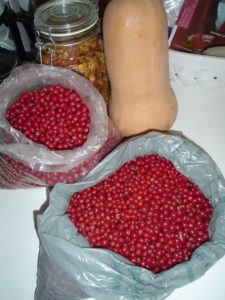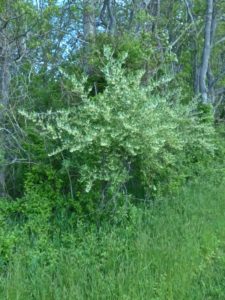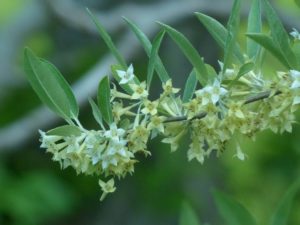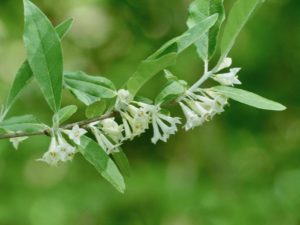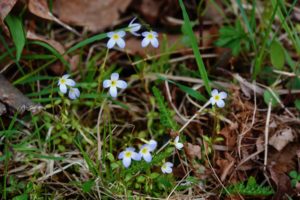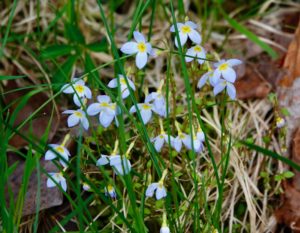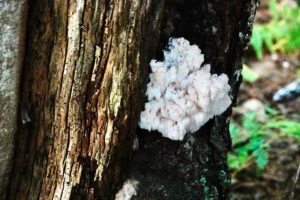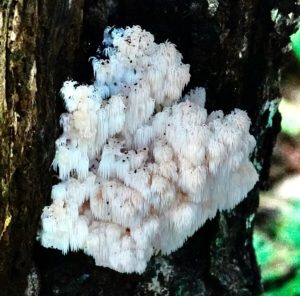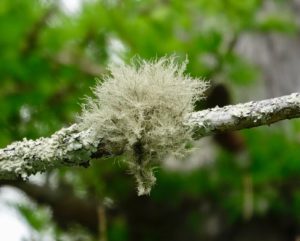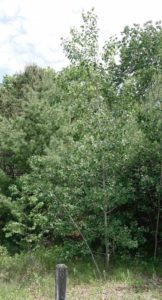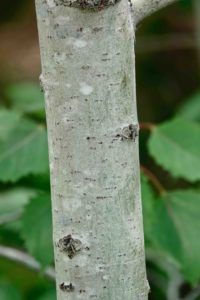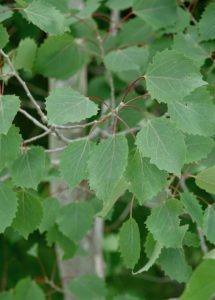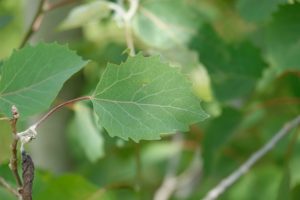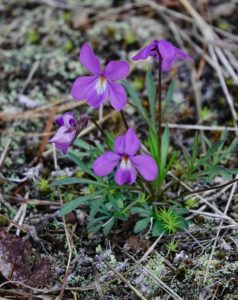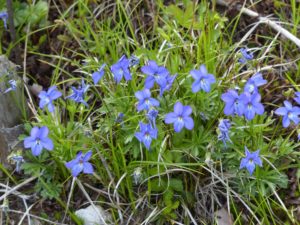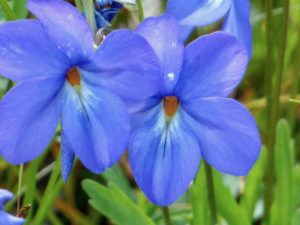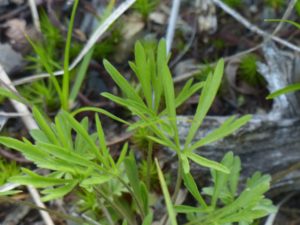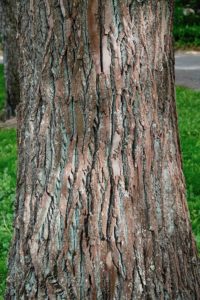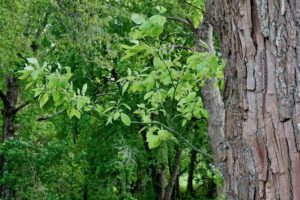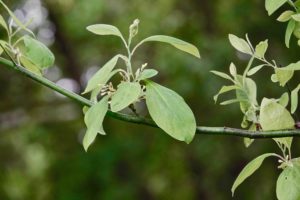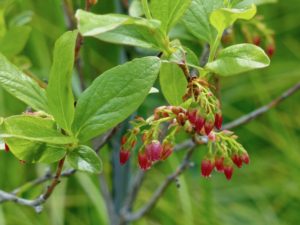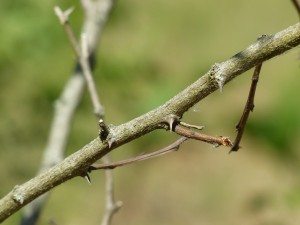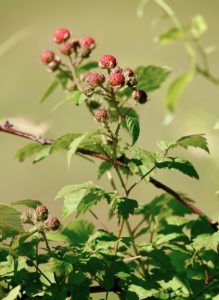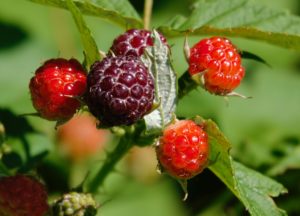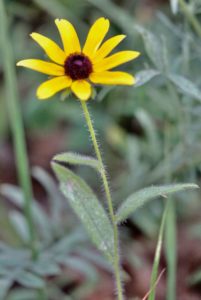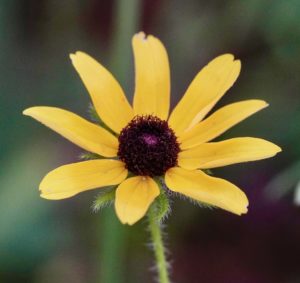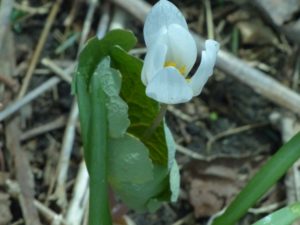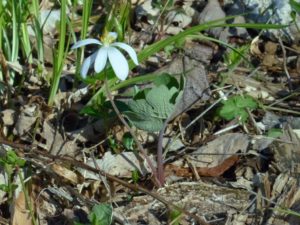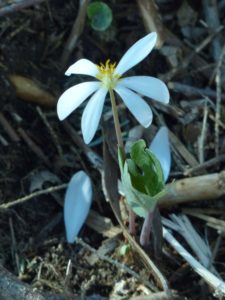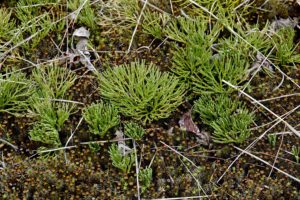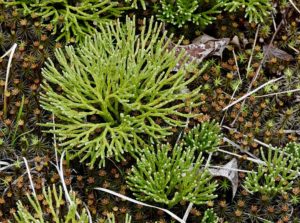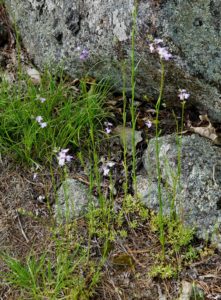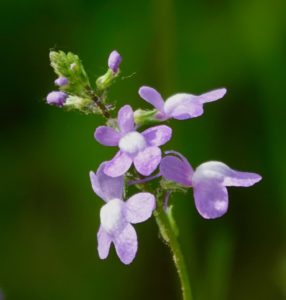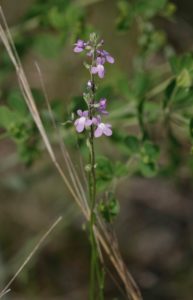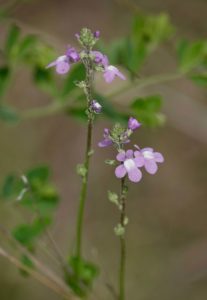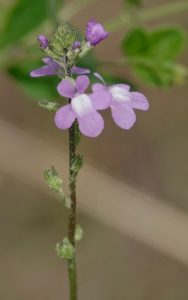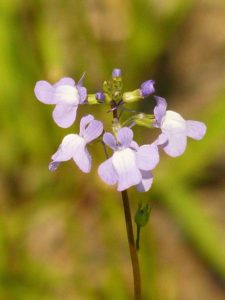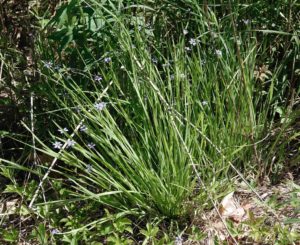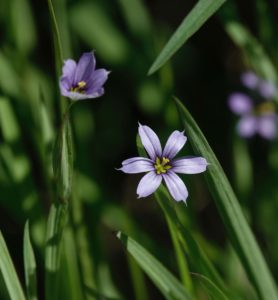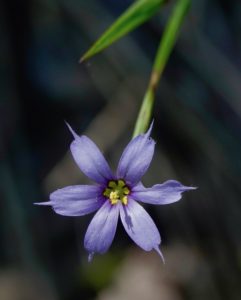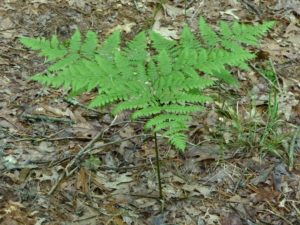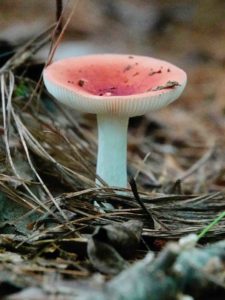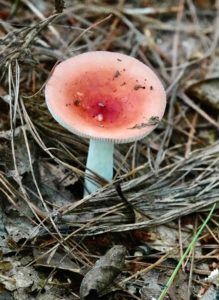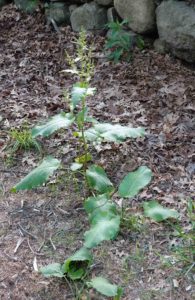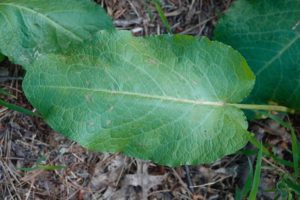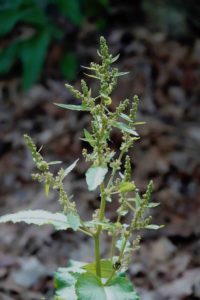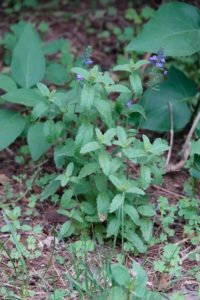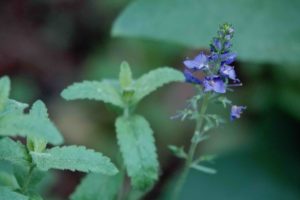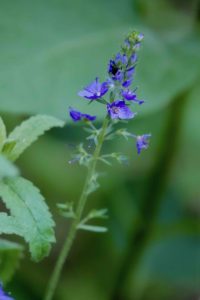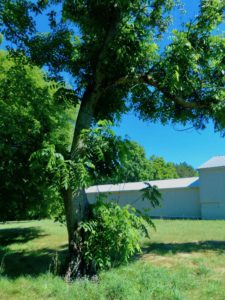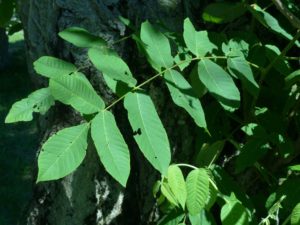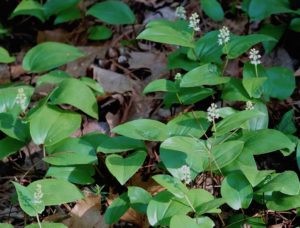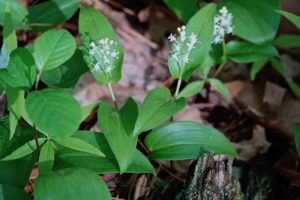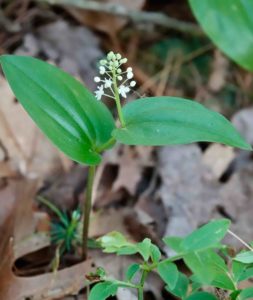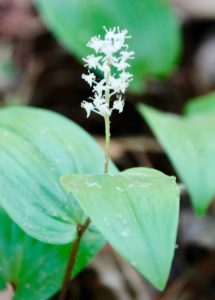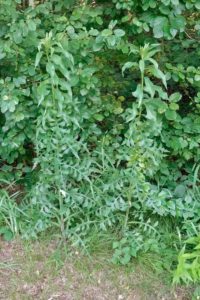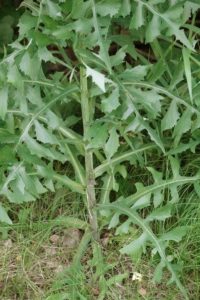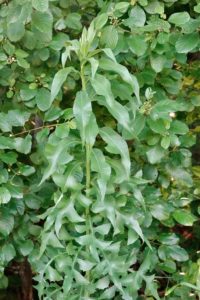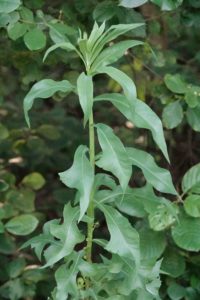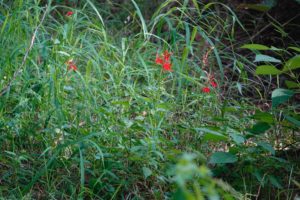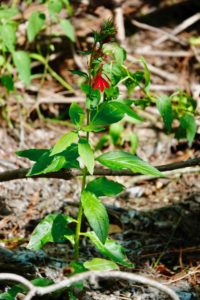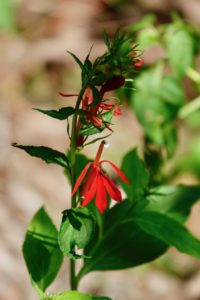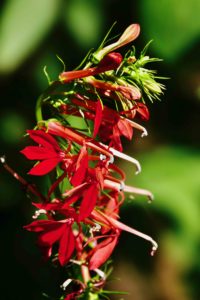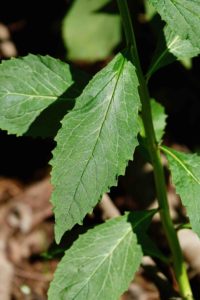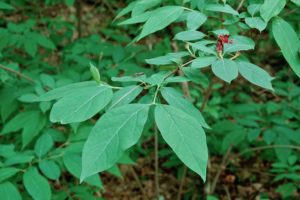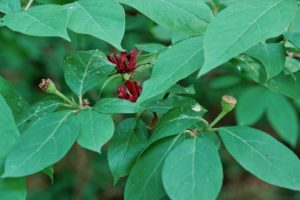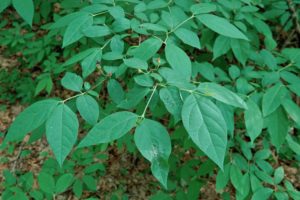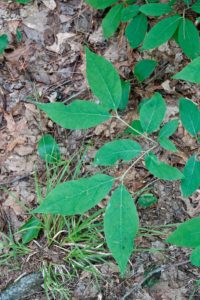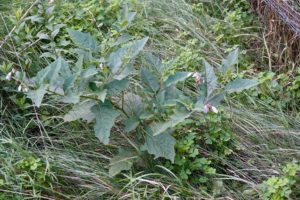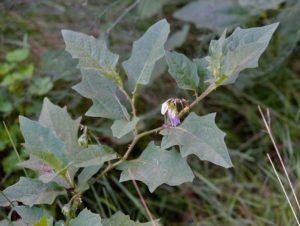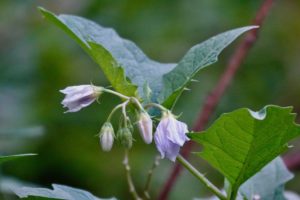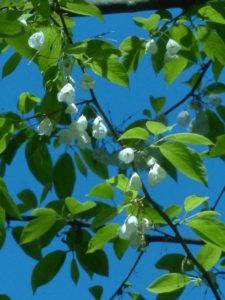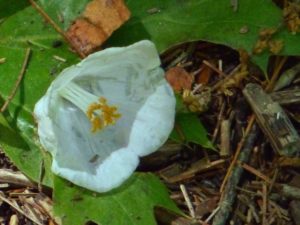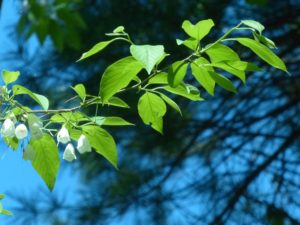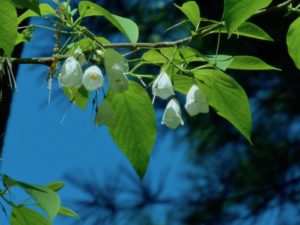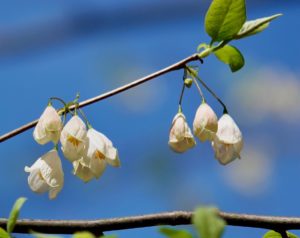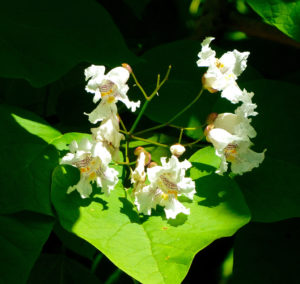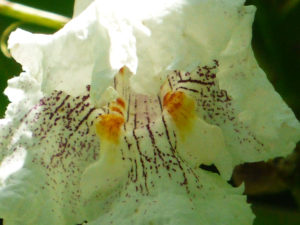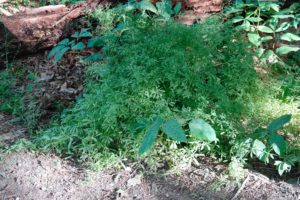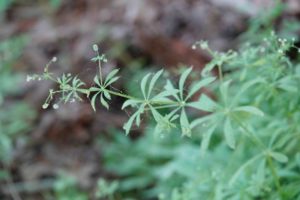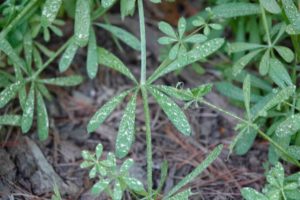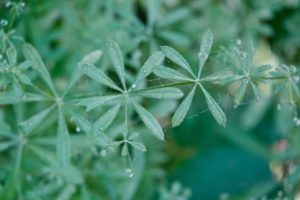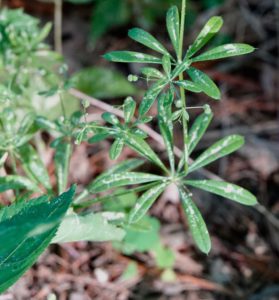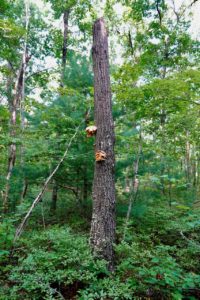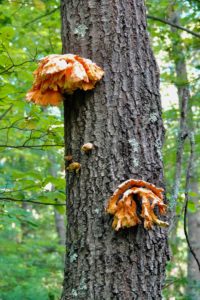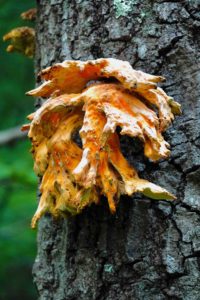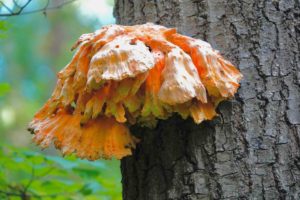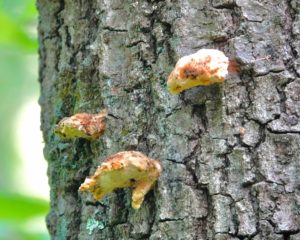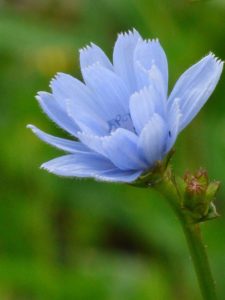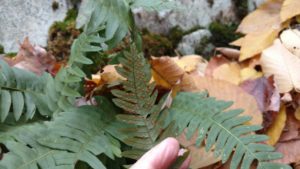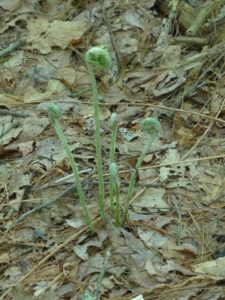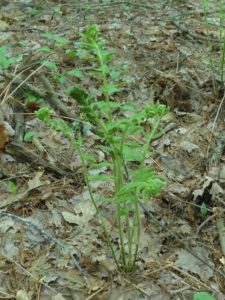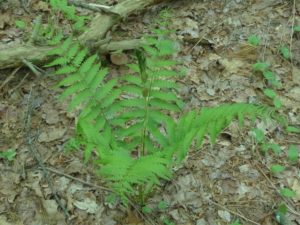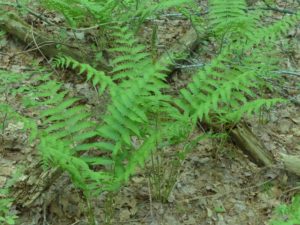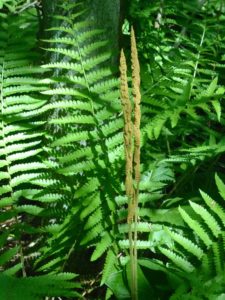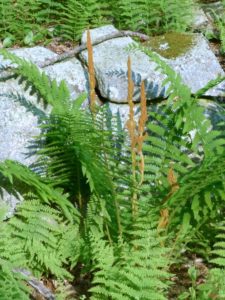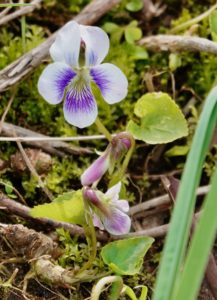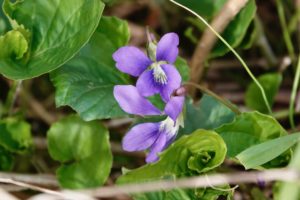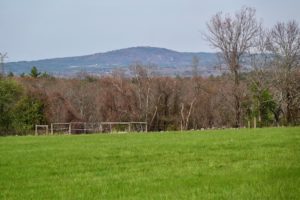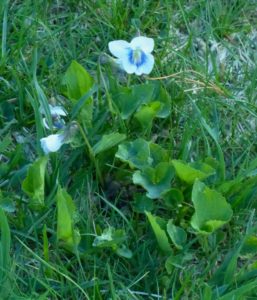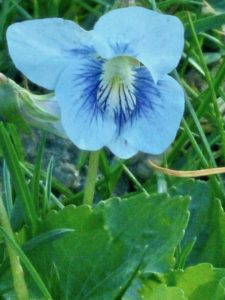Sightings – Plants
Observer: Paul Lauenstein
Observation Date: 5/23/23
Observation Time: 7:35 a.m.
Observation Location: Moose Hill Audubon WIldlife Sanctuary (boardwalk)
Common Name: Alder Buckthorn
Scientific Name: Frangula alnus
Comments: Alder buckthorn, also known as glossy buckthorn, is a tall shrub. I saw a hummingbird moving from tiny blossom to tiny blossom. Otherwise I probably would not have noticed that it was in bloom. I also saw some bees and wasps feeding on the tiny blossoms.
Alder buckthorn does not have thorns. It was introduced in eastern North America from Asia about a century ago. It is now widespread and invasive. Birds eat the berries when they ripen in fall.
More Information: Wikipedia
Observer: Paul Lauenstein
Observation Date: 8/15/18
Observation Time: 12:15 p.m.
Observation Location: Moose Hill Audubon Wildlife Sanctuary
Common Name: Amanita mushroom
Scientific Name: Amanita sp.
Comments: The genus of this mushroom is probably Amanita, but it’s hard to say which of the numerous species of Amanita this is. Mushrooms of the genus Amanita account for most mushroom-related deaths.
More information: MushroomExpert.com
Observer: Paul Lauenstein
Observation Date: 5/19/19
Observation Time: 3:10 p.m.
Observation Location: Billings Loop Botanical Trail
Common Name: American Beech Tree
Scientific Name: Fagus grandifolia
Comments: These specimens were observed in a shady, wooded area. The American Beech is a shade-tolerant species, favoring shade more than other trees, commonly found in forests in the final stage of succession. Ecological succession is essentially the process of forests changing their composition through time; it is a pattern of events often observed on disturbed sites. Although sometimes found in pure stands, it is more often associated with sugar maple (forming the beech-maple climax community), yellow birch, and eastern hemlock, typically on moist well-drained slopes and rich bottomlands.
More Information: Wikipedia
Observer: Paul Lauenstein
Observation Date: 5/22/18
Observation Time: 10:45 a.m.
Observation Location: Town-owned conservation land near Sandy Ridge Circle
Common Name: American Beech tree
Scientific Name: Fagus grandifolia
Comments: The American Beech is a shade-tolerant species, favoring shade more than other trees, commonly found in forests in the final stage of succession. Ecological succession is essentially the process of forests changing their composition through time; it is a pattern of events often observed on disturbed sites. Although sometimes found in pure stands, it is more often associated with sugar maple (forming the beech-maple climax community), yellow birch, and eastern hemlock, typically on moist well drained slopes and rich bottomlands.
More Information: Wikipedia
Observer: Rita Corey
Observation Date: 8/13/20
Observation Time: 2:00 p.m.
Observation Location: Rattlesnake Hill
Common Name: American burnweed (a.k.a. fireweed)
Scientific Name: Erechtites hieraciifolius
Comments: Burnweed is a native annual in the daisy family, Asteraceae. American Burnweed is an underrated and unappreciated wild edible. Although Burnweed has no history as a food source here in America, everywhere else in the world where it grows it is eaten. It’s a common food in all of Asia and most of Europe. It also has medicinal properties2. The oil derived from the plant can be used to treat wounds, hemorrhages, poison ivy rashes, and other ailments such as piles.
Burnweed got its unique name by being one of the first plants to grow after a fire has burned out an area. Burnweed is also referred to as fireweed.
More Information: Go Botany
Observer: Paul Lauenstein
Observation Date: 4/19/15
Observation Time: 2:35 p.m.
Observation Location: Moose Hill Audubon Wildlife Sanctuary
Common Name: American Chestnut
Scientific Name: Castanea dentata
Comments: American chestnut was once very common in New England, but it has been practically wiped out by the chestnut blight, a pathogenic fungus. The fungus does not kill the roots, which continue to send up shoots for years. However, the fungus usually prevents the shoots from maturing into nut-bearing trees.
More Information: Wikipedia
This chestnut tree in the woods at Moose Hill has managed to survive despite being partially girdled by the blight. It has actually grown large enough to produce nuts.
Chestnuts on the ground:
This photo taken 8/6/10 shows what American Chestnut leaves look like:
Observer: Paul Lauenstein
Observation Date: 6/24/10
Observation Time: 3:45 p.m.
Observation Location: Beaver Brook near tennis courts
Common Name: American Chestnut Tree
Scientific Name: Castanea dentata
Comments: The term “dentata” in the scientific name refers to the “teeth” around the edges of the leaves. American chestnut trees were decimated by chestnut blight. Remnant root systems continue to send up shoots such as those shown in the photos, but the blight prevents most of these shoots from getting large enough to produce nuts.
More Information: Wikipedia
Observer: Paul Lauenstein
Observation Date: 6/13/20
Observation Time: 5:30 p.m.
Observation Location: Moose Hill Audubon Wildlife Sanctuary
Common Name: American Groundnut
Scientific Name: Apios americana
Comments: Apios americana is found in every state east of the Rocky Mountains. It is a perennial vine that grows to 10 feet long in wet areas – marshy meadows and thickets, stream and pond banks, and moist woodlands. Both the tuber and the seeds are edible. Apios americana was a noteworthy food of both native Americans as well as early colonists of New England. It is a good source of carbohydrates and protein.
More Information: Wildflowers of the United States
Observer: Paul Lauenstein
Observation Date: 7/11/15
Observation Time: 1:36 p.m.
Observation Location: near Gavins Pond
Common Name: American Groundnut
Scientific Name: Apios americana
Comments: Apios americana is found in every state east of the Rocky Mountains. It is a perennial vine that grows to 10 feet long in wet areas – marshy meadows and thickets, stream and pond banks, and moist woodlands. Both the tuber and the seeds are edible. Apios americana was a noteworthy food of both native Americans as well as early colonists of New England. It is a good source of carbohydrates and protein.
More Information: Wildflowers of the United States
Observer: Paul Lauenstein
Observation Date: 6/23/19
Observation Time: 10:45 p.m.
Observation Location: Billings Loop Botanical Trail
Common Name: American Hornbeam
Scientific Name: Carpinus caroliniana
Comments: The common English name hornbeam derives from the hardness of the wood (likened to animal horn) and the Old English beam, meaning “tree” (cognate with German Baum). The American hornbeam is also occasionally known as blue-beech, ironwood, or musclewood, the first from the resemblance of the bark to that of the American beech Fagus grandifolia, the other two from the hardness of the wood and the muscular appearance of the trunk, respectively. Hornbeams are used as food plants by the larvae of some Lepidoptera species (i.e. butterflies and moths), including autumnal moth, common emerald, feathered thorn, walnut sphinx, Svensson’s copper underwing, and winter moth.
More Information: Wikipedia
Observer: Paul Lauenstein
Observation Date: 6/4/11
Observation Time: 4:20 p.m.
Observation Location: Conservation land near Billings Street
Common Name: American Hornbeam
Scientific Name: Carpinus caroliniana
Comments: The common English name hornbeam derives from the hardness of the wood (likened to animal horn) and the Old English beam, meaning “tree” (cognate with German Baum). The American hornbeam is also occasionally known as blue-beech, ironwood, or musclewood, the first from the resemblance of the bark to that of the American beech Fagus grandifolia, the other two from the hardness of the wood and the muscular appearance of the trunk, respectively. Hornbeams are used as food plants by the larvae of some Lepidoptera species (i.e. butterflies and moths), including autumnal moth, common emerald, feathered thorn, walnut sphinx, Svensson’s copper underwing, and winter moth.
More Information: Wikipedia
Observer: Paul Lauenstein
Observation Date: 6/24/21
Observation Time: 3:40 p.m.
Observation Location: Moose Hill Farm (TTOR)
Common Name: Amur Cork Tree
Scientific Name: Phellodendron amurense
Comments: Phellodendron amurense is a perennial tree that can grow from 35-45 ft. (10-14 m) tall. The tree has a short trunk with spreading branches. The bark is thick and corky.
This tree is demonstrating invasive characteristics in suburban and urban fringe forests. It escapes intended plantings to invade and displace native hardwood forest. Note: only female plants have potential to become invasive. Phellodendron amurense is native to eastern Asia and was introduced into the United States in 1856. Trees prefer full sun and rich soils.
More Information: Invasive Plant Atlas
Observer: Paul Lauenstein
Observation Date: 5/16/23
Observation Time: 4:55 p.m.
Observation Location: Moose Hill Audubon Wildlife Sanctuary
Common Name: Ash Tree (diseased)
Scientific Name: genus Fraxinus
Comments: This tree was killed by emerald ash borer beetles, which have killed millions of ash trees and threaten the future of ash trees.
More Information: Britannica
Observer: Paul Lauenstein
Observation Date: 5/22/18
Observation Time: 9:35 a.m.
Observation Location: banks of Beaver Brook (upstream of the tennis courts)
Common Name: Atlantic White Cedar tree
Scientific Name: Chamaecyparis thyoides
Comments: Atlantic White Cedars live almost exclusively in freshwater wetlands and are considered an obligate wetland species. They prefer habitats where the soil is saturated with water at least during the majority of the growing season. Though this tree species is not listed as threatened, Atlantic White Cedar wetlands are considered a globally threatened ecosystem, and often serve as carbon sinks because of their peat-building abilities. Caterpillars of the Hessel’s Hairstreak butterfly feed exclusively on C. thyoides, where its green color helps keep it camouflaged.
Sharon’s 250-acre Atlantic White Cedar swamp naturally purifies and stores the rainwater that recharges the springs that feed Lake Massapoag and the aquifers that provide Sharon residents with drinking water.
More Information: Wikipedia
The bark of Atlantic White Cedars has a spiral pattern up the tree trunk:
Observer: Paul Lauenstein
Observation Date: 11/6/06
Observation Time: 2:10 p.m.
Observation Location: Gavins Pond Road
Common Name: Autumn Olive
Scientific Name: Elaeagnus umbellata
Comments: Autumn-olive is a hardy, prolific shrub that thrives in a variety of conditions, in part because it is capable of fixing nitrogen. Some varieties can produce up to 80 pounds (37 kilos) of bright red edible berries in a season, which ripen in October and give the plant its common name. Introduced from Japan in 1830 and widely planted in the 1940s to revegetate disturbed habitats, it is now invasive in many parts of North America. Birds (especially starlings) and mammals relish its copious fruits and spread it far and wide.
Having a sweet and tart flavor when ripe, the berries can be eaten fresh or processed for jam, condiments, or fruit leather. When mature, the red berries contain carotenoids, including considerable amounts of lycopene, a substance also found in tomatoes, watermelon, pink grapefruit, pink guava, papaya, and rosehip.
More Information: Go Botany and Wikipedia
Observer: Paul Lauenstein
Observation Date: 5/23/18
Observation Time: 9:10 a.m.
Observation Location: Moose Hill Farm (TTOR)
Common Name: Autumn Olive
Scientific Name: Elaeagnus umbellata
Comments: Autumn-olive is a hardy, prolific shrub that thrives in a variety of conditions, in part because it is capable of fixing nitrogen. Some varieties can produce up to 80 pounds (37 kilos) of bright red edible berries in a season, which ripen in October and give the plant its common name. Introduced from Japan in 1830 and widely planted in the 1940s to revegetate disturbed habitats, it is now invasive in many parts of North America. Birds (especially starlings) and mammals relish its copious fruits and spread it far and wide.
Having a sweet and tart flavor when ripe, the berries can be eaten fresh or processed for jam, condiments, or fruit leather. When mature, the red berries contain carotenoids, including considerable amounts of lycopene, a substance also found in tomatoes, watermelon, pink grapefruit, pink guava, papaya, and rosehip.
Observer: Paul Lauenstein
Observation Date: 5/26/19
Observation Time: 2:40 p.m.
Observation Location: Moose Hill Farm (TTOR)
Common Name: Autumn Olive
Scientific Name: Elaeagnus umbellata
Comments: Autumn-olive is a hardy, prolific shrub that thrives in a variety of conditions, in part because it is capable of fixing nitrogen. Some varieties can produce up to 80 pounds (37 kilos) of bright red edible berries in a season, which ripen in October and give the plant its common name. Introduced from Japan in 1830 and widely planted in the 1940s to revegetate disturbed habitats, it is now invasive in many parts of North America. Birds (especially starlings) and mammals relish its copious fruits and spread it far and wide.
The undersides of the leaves are silvery green – noticeably lighter than the top sides.
Having a sweet and tart flavor when ripe, the berries can be eaten fresh or processed for jam, condiments, or fruit leather. When mature, the red berries contain carotenoids, including considerable amounts of lycopene, a substance also found in tomatoes, watermelon, pink grapefruit, pink guava, papaya, and rosehip.
More Information: Go Botany and Wikipedia and Wintergreen Botanicals
Observer: Paul Lauenstein
Observation Date: 4/27/23
Observation Time: 3:45 p.m.
Observation Location: Moose Hill Farm (TTOR)
Common Name: Azure Bluet
Scientific Name: Houstonia caerulea
Comments: Azure bluets are also know as Quaker ladies.
More Information: Wikipedia
Observer: Paul Lauenstein
Observation Date: 6/2/11
Observation Time: 1:00 p.m.
Observation Location: Gavins Pond Road near soccer field parking lot
Common Name: Beach Rose
Scientific Name: Rosa rugosa
More Information: University of Rhode Island
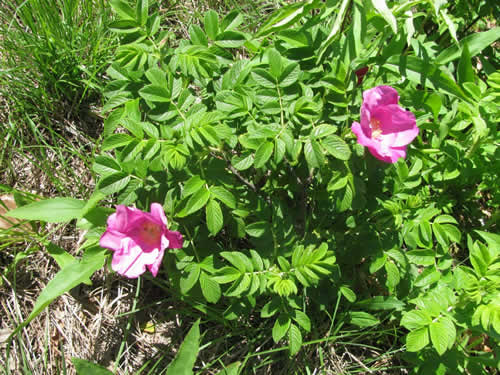
Observer: Paul Lauenstein
Observation Date: 10/6/21
Observation Time: 3:00 p.m.
Observation Location: Near the footbridge over Beaver Brook near the outbound train station
Common Name: Bear’s Head Tooth Fungus (a.k.a. Lion’s Mane or Comb Tooth)
Scientific Name: Hericium americanum
Comments: While driving very slowly along the dirt road from the outbound train station parking lot to the footbridge over Beaver Brook, I almost drove past this bizarre fungus growing on a dying tree trunk. This year was exceptionally wet, which has led to more mushrooms than usual this fall.
Bear’s Head Tooth Fungus is native to eastern North America. It was first scientifically described by James Ginns of Canada in 1984. Bear’s Head Tooth Fungus grows on both rotting and living wood, mostly hardwood, and they are typically seen in the wild during the late summer and autumn months, though they are able to be cultivated.
Young Bear’s Head Tooth Fungus can be cooked and eaten, having a taste comparable to that of lobster, though once picked the fungi do not store well, and need to be consumed within a couple of days. Otherwise they will become bitter. High amounts of vitamin D are found in Bear’s Head Tooth Fungus, and it also contains significant quantities of protein and fibre, as well as other beneficial health properties that are still being understood. However, I never eat mushrooms or fungi that I find in the wild. With plenty of mushrooms available in the supermarket, I don’t think it’s worth the risk.
More Information: Wikipedia and ediblewildfood.com
Observer: Paul Lauenstein
Observation Date: 4/25/23
Observation Time: 1:27 p.m.
Observation Location: Gavins Pond Rd. (my back yard)
Common Name: Beard lichen
Scientific Name: Usnea strigosa
Comments: Also called bushy beard, this epiphytic (i.e. growing on trees) lichen is a composite organism that emerges from algae or cyanobacteria living among the filaments of the fungi in a symbiotic (mutually beneficial) relationship. The fungi benefit from the carbohydrates produced by the algae or cyanobacteria via photosynthesis. The algae or cyanobacteria benefit by being protected from the environment by the filaments of the fungi, which also gather moisture and nutrients from the environment, and (usually) provide an anchor to it.
More Information: Wisconsin Dept. of Natural Resources
Observer: Paul Lauenstein
Observation Date: 6/9/20
Observation Time: 2:00 p.m.
Observation Location: near soccer parking lot on Gavins Pond Road
Common Name: Bigtooth Aspen Tree
Scientific Name: Populus grandidentata
Comments: Bigtooth Aspen (Populusgrandidentata) is a native deciduous tree, which grows throughout northeastern North America. It is a member of the willow family. A fast-growing, but short-lived, pioneer species, Bigtooth Aspen attains heights of 60 to 80 feet.
More Information: WildAdirondacks.org
Observer: Paul Lauenstein
Observation Date: 5/12/11
Observation Time: 8:15 a.m.
Observation Location: meadow near Gavins Pond dam
Common Name: Bird’s Foot Violet
Scientific Name: Viola pedata
Comments: The leaves of this pretty wildflower are reminiscent of bird’s feet. Not a common violet locally, only one site in Blue Hills. Likes dry sandy soils; has also been spotted in woods north of Knollwood Cemetery in Sharon.
More Information: US Wildflowers Database (USDA)
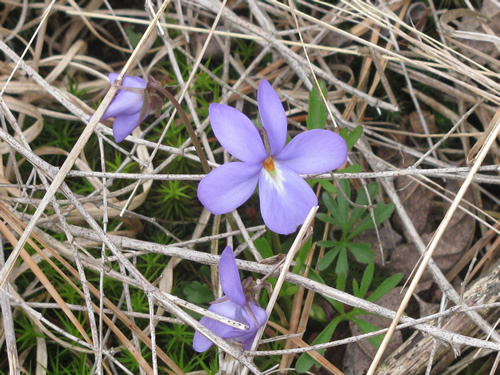
Observer: Paul Lauenstein
Observation Date: 5/19/20
Observation Time: 9:20 a.m.
Observation Location: near Gavins Pond
Common Name: Bird’s Foot Violet
Scientific Name: Viola pedata
Comments: Bird-foot violets are perennials with five-petaled flowers that bloom from March to June. The flowers are typically blue, but can range from white to purple. They spread by sending out rhizomes. The fan-shaped leaves have three lobes which are said to resemble a bird’s feet.
More Information: US Wildflowers Database (USDA)
Observer: Paul Lauenstein
Observation Date: 5/27/19
Observation Time: 4:40 p.m.
Observation Location: Power lines near Walpole St.
Common Name: Bird’s Foot Violet
Scientific Name: Viola pedata
Comments: Bird-foot violets are perennials with five-petaled flowers that bloom from March to June. The flowers are typically blue, but can range from white to purple. They spread by sending out rhizomes. The fan-shaped leaves have three lobes which are said to resemble a bird’s feet.
More Information: US Wildflowers Database (USDA)
Observer: Paul Lauenstein
Observation Date: 5/30/14
Observation Time: 12:05 p.m.
Observation Location: Power lines near Walpole St.
Common Name: Bird’s Foot Violet
Scientific Name: Viola pedata
Comments: Bird-foot violets are perennials with five-petaled flowers that bloom from March to June. The flowers are typically blue, but can range from white to purple. They spread by sending out rhizomes. The fan-shaped leaves have three lobes which are said to resemble bird feet.
More Information: US Wildflowers Database (USDA)
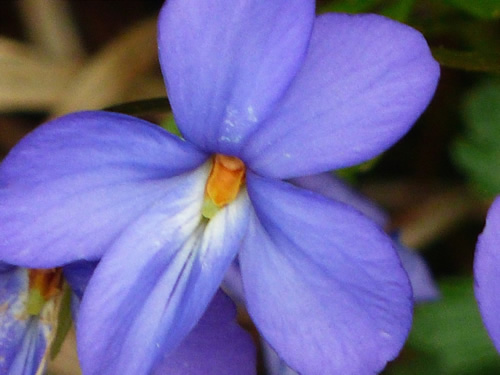
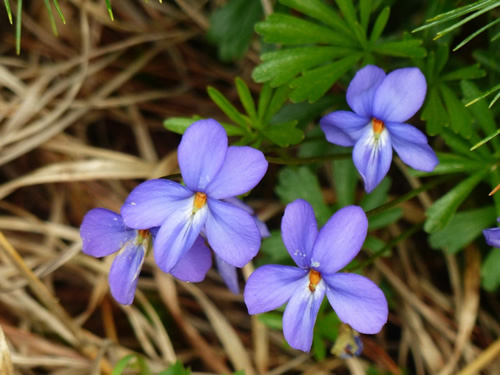
Observer: Paul Lauenstein
Observation Date: 6/6/11
Observation Time: 1:40 p.m.
Observation Location: Gavins Pond Road (bridge near soccer
fields)
Common Name: Bittersweet Nightshade
Scientific Name: Solanum dulcamara
More Information: King County, WA
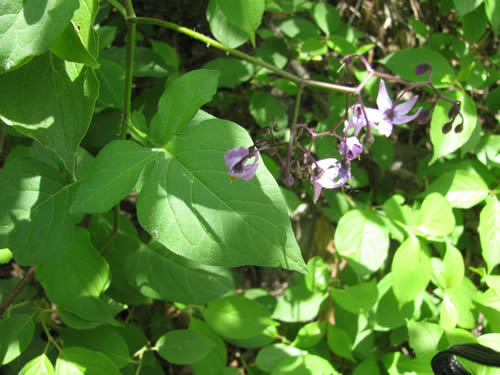
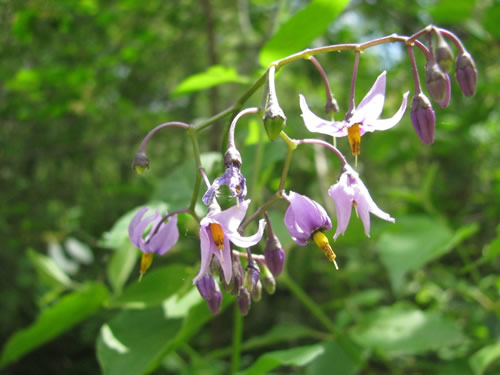
Observer: Paul Lauenstein
Observation Date: 5/31/20
Observation Time: 5:15 p.m.
Observation Location: Trustees of Reservations’ Moose Hill Farm
Common Name: Black Gum Tree
Scientific Name: Nyssa sylvatica
Comments: Also known as black tupelo, this is one of the most attractive native trees around. Summer leaves are a dark green with a high-gloss appearance, but the most spectacular part of this tree is the fall foliage with many shades of yellow, orange, bright red, purple or scarlet that may appear on the same branch. Bark resembles alligator hide. Fruit is bluish-black and is loved by many birds. Grows 30′-50′ high, with a 20′-30′ spread. Prefers well-drained, acid soils, and full sun to partial shade.
More Information: Arbor Day Foundation
Observer: Paul Lauenstein
Observation Date: 5/27/19
Observation Time: 4:20 p.m.
Observation Location: Beneath high tension wires near So. Walpole St.
Common Name: Black Huckleberry
Scientific Name: Gaylussacia baccata
Comments: These are the distinctive bright red unopened flower buds of black huckleberry, Gaylussacia baccata. They are typically no more than waist-high. They often form a near-continuous shrub layer in dryish oak woods. In moister soils they tend to be replaced by dangleberry, Gaylussacia frondosa.
Blueberry bushes are similar, but have green rather than blackish second-year twigs. The berries of huckleberries are very similar to the berries of blueberries, except the latter usually contain more seeds (8-20) that are smaller in size. The foliage and woody stems of Black Huckleberry are quite similar to those of low-bush blueberries (particularly Vaccinium pallidum), except the leaf undersides of the former shrub are covered with resinous yellow dots, while the leaf undersides of blueberries lack such resinous dots.
More Information: Illinois Wildflowers
Observer: Paul Lauenstein
Observation Date: 5/30/15
Observation Time: 3:30 p.m.
Observation Location: near Gavins Pond
Common Name: Black Locust tree
Scientific Name: Robinia pseudocacia
Comments: The blossoms of black locust trees are good to eat, but beware of the thorns.
More Information: The Foraged Foodie
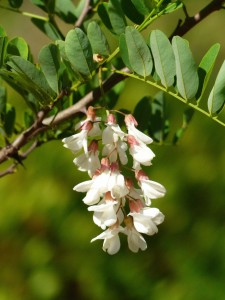
Observer: Paul Lauenstein
Observation Date: 6/24/21
Observation Time: 3:10 p.m.
Observation Location: Moose Hill Farm (TTOR)
Common Name: Black Raspberry
Scientific Name: Rubus occidentalis
Comments: The black raspberry is related to the red raspberry Rubus idaeus and Rubus strigosus, sharing the white underside of leaves, and fruit that readily detaches from the carpel.
Black raspberry grows in disturbed areas and in meadows, often near streams and lakes, trails or roadways. The native range of Rubus occidentalis extends as far east as New Brunswick, as far west as Nebraska, as far north as Quebec, and as far south as Mississippi.
More Information: Wikipedia
Observer: Paul Lauenstein
Observation Date: 7/12/20
Observation Time: 6:50 p.m.
Observation Location: along Gavins Pond Road
Common Name: Black-eyed Susan
Scientific Name: Rudbeckia hirta
Comments: Related to cone flowers, this native biennial forms a rosette of leaves the first year, followed by flowers the second year. It is covered with hairs that give it a slightly rough texture.
More Information: USDA and wildflower.org
Observer: Paul Lauenstein
Observation Date: 7/23/09
Observation Time: 9:30 a.m.
Observation Location: Gavins Pond Road
Common Name: Black-eyed Susans
Scientific Name: Rudbeckia hirta
Comments: The genus name honors Olaus Rudbeck, who was a professor of botany at the University of Uppsala in Sweden and was one of Linnaeus’s teachers. The specific epithet “hirta” refers to the trichomes (hairs) occurring on leaves and stems.
More Information: USDA
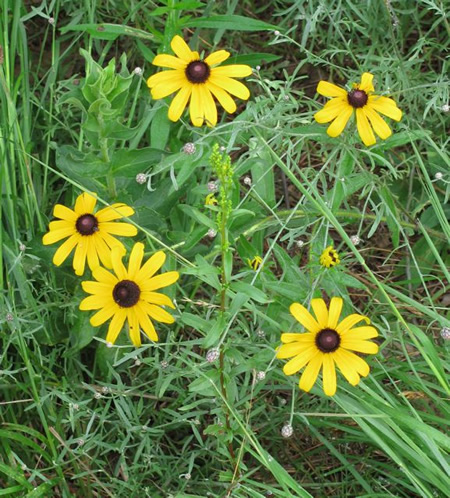
Observer: Paul Lauenstein
Observation Date: 7/5/13
Observation Time: 6:15 p.m.
Observation Location: Gavins Pond area
Common Name: Black-eyed Susans
Scientific Name: Rudbeckia hirta
Comments: A type of daisy, these were growing wild in the field near Gavins Pond Dam.
More Information: USDA
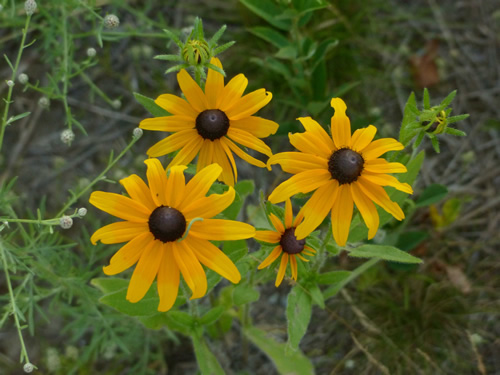
Observer: Paul Lauenstein
Observation Date: 5/1/18
Observation Time: 10:30 a.m.
Observation Location: Moose Hill Audubon Wildlife Sanctuary
Common Name: Bloodroot
Scientific Name: Sanguinaria canadensis
Comments: Blood-root is an attractive spring ephemeral, traditionally used in cough remedies. However, it has been characterized as unsafe by the United States Food and Drug Administration because of the presence of the toxic alkaloid sanguinarine. This flower drops its petals within a day or two of blooming.
Please do not dig up wildflowers!
More Information: Go Botany
Observer: Paul Lauenstein
Observation Date: 5/31/11
Observation Time: 3:15 p.m.
Observation Location: Gavins Pond area
Common Name: Blue Flag Iris
Scientific Name: Iris versicolor
More Information: Wikipedia
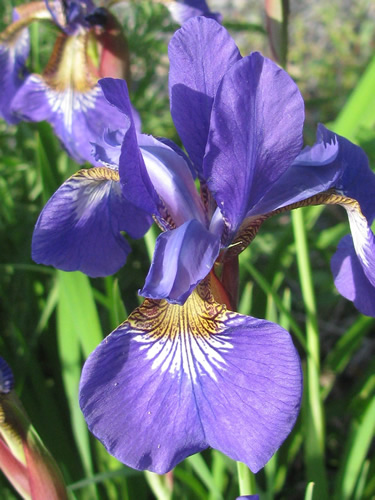
Observer: Peter Higgins
Observation Date: 06/08/08
Observation Time: 6:55 a.m.
Observation Location: Moose Hill Audubon Wildlife Sanctuary
Common Name: Blue Flag Iris
Scientific Name: Iris versicolor
Comments: This beautiful group of wild blue flag iris was growing in the field near the boardwalk.
More Information: LakeForest.edu

Observer: Paul Lauenstein
Observation Date: 5/18/20
Observation Time: 9:30 a.m.
Observation Location: sandy high ground under high tension lines across the street from the Gavins Pond soccer fields
Common Name: Blue Ground-cedar
Scientific Name: Diphasiastrum tristachyum
Comments: Diphasiastrum tristachyum, commonly known as blue clubmoss, blue ground-cedar, ground pine, deep-rooted running-pine or ground cedar, is a North American and Eurasian species of perennial clubmoss. In North America, it has been found from Newfoundland west to Manitoba, and south as far as Georgia and Alabama. It grows from creeping underground stems which are often deeply buried at 5–12 cm deep. The above ground stems emerge at nodes from the underground stem.
Observer: Paul Lauenstein
Observation Date: 5/16/23
Observation Time: 4:15 p.m.
Observation Location: Moose Hill Audubon Wildlife Sanctuary (Bluff Trail)
Common Name: Blue Toadflax
Scientific Name: Nuttallanthus canadensis
Comments: These diminutive wildflowers bloom from April to September. At first glance they look like nondescript spindly weeds, but viewed up close they are stunningly beautiful.
More Information: Conn. Botanical Society
Observer: Paul Lauenstein
Observation Date: 5/31/11
Observation Time: 4:05 p.m.
Observation Location: Gavins Pond area
Common Name: Blue Toadflax
Scientific Name: Nuttallanthus canadensis
More Information: Conn. Botanical Society
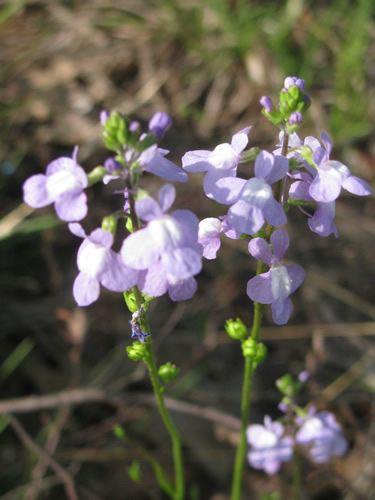
Observer: Paul Lauenstein
Observation Date: 6/9/20
Observation Time: 2:50 p.m.
Observation Location: meadow near Gavins Pond dam
Common Name: Blue Toadflax
Scientific Name: Nuttallanthus canadensis
Comments: These diminutive wildflowers bloom from April to September.
More Information: Conn. Botanical Society
Observer: Paul Lauenstein
Observation Date: 7/11/15
Observation Time: 3:15 p.m.
Observation Location: Gavins Pond area
Common Name: Blue Toadflax
Scientific Name: Nuttallanthus canadensis
Comments: Flowers from April to September.
More Information: Conn. Botanical Society
Observer: Paul Lauenstein
Observation Date: 5/30/20
Observation Time: 3:05 p.m.
Observation Location: Moose Hill Farm (TTOR)
Common Name: Blue-eyed grass
Scientific Name: Sisyrinchium angustifolium
Comments: Blue-eyed grass grows in fields, meadows and the edges of wetlands. This clump was growing along the dirt road under the high-tension lines. Except in spring when its small, blue flowers make it conspicuous, this plant is hard to pick out among other kinds of grasses.
Native Americans cooked and ate the greens, and used the plant medicinally to regulate the bowels.
More Information: Go Botany
Observer: Paul Lauenstein
Observation Date: 5/14/11
Observation Time: 3:20 p.m.
Observation Location: meadow near Gavins Pond dam
Common Name: Blueberry
Scientific Name: Vaccinium corymbosum
Comments: Blueberries grow wild in the woods around Sharon, often near ponds and streams, where their roots can access moisture during dry weather. They flower in May and ripen in mid-summer.
More Information: Mother Earth News

Observer: Paul Lauenstein
Observation Date: 6/29/11
Observation Time: 11:35 a.m.
Observation Location: Gavins Pond
Common Name: Blueberry
Scientific Name: Vaccinium
Comments: These unripe blueberries were growing in sandy soil in the vicinity of Gavins Pond near a bluebird nesting box. The baby bluebirds will probably fledge around the time the berries ripen.
More Information: Mother Earth News
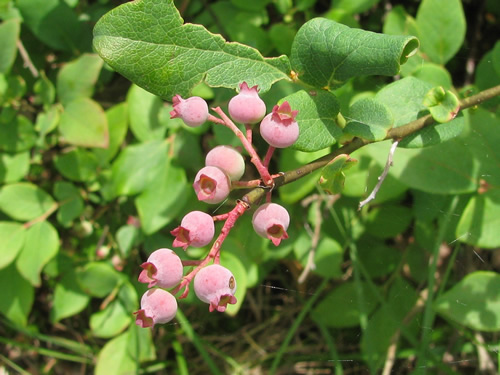
Observer: Kurt Buermann
Observation Date: 7/14/13
Observation Time: 11:00 a.m.
Observation Location: backyard
Common Name: Bondarzewia
Scientific Name: Bondarzewia berkeleyi
Comments: This was growing on an old oak stump. Very large, 2 ft long clusters. It grew very quickly, over a day or so. This is not chicken-of-the-woods, but is edible if gathered when very young.
More Information: MushroomExpert.com
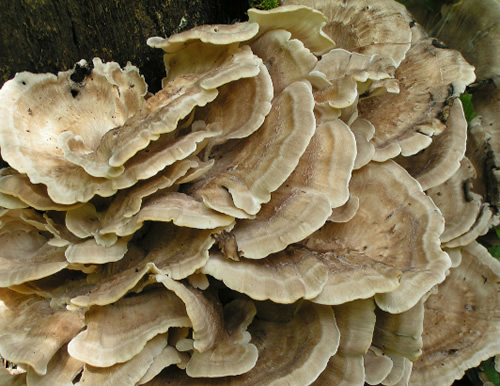
Observer: Paul Lauenstein
Observation Date: 5/23/18
Observation Time: 9:45 a.m.
Observation Location: Moose Hill Farm (TTOR)
Common Name: Bracken Fern
Scientific Name: Pteridium aquilinum
Comments: Bracken fern often becomes dominant after disturbances such as fire, logging and grazing due to its deep rhizome. Humans have used bracken fern for thatch, livestock, bedding, and food, though it does contain some toxic compounds.
More Information: Go Botany
Observer: Paul Lauenstein
Observation Date: 12/4/09
Observation Time: 3:30 p.m.
Observation Location: Gavins Pond Road opposite soccer fields
Common Name: British Soldier Lichen
Scientific Name: Cladonia cristatella
More Information: Backyard Nature: Lichen
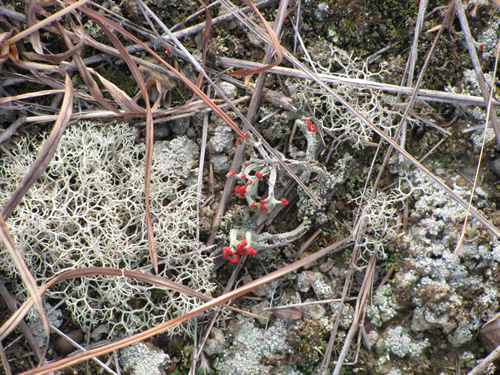
Compare the British soldier lichen to the pink earth lichen below. These photos were taken at about the same time, and in the same area.
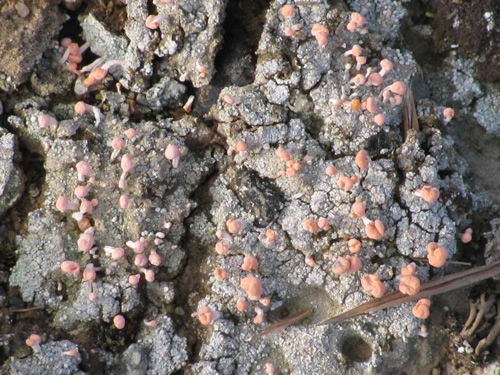
Observer: Paul Lauenstein
Observation Date: 9/7/20
Observation Time: 5:45 p.m.
Observation Location: conservation land near Lakeview & Morse
Common Name: Brittle Gill Mushroom
Scientific Name: Russula pulchra
Comments: Wikipedia lists an enormous number of Russula species, so I am not certain of this identification.
More Information: Mushroom Expert
Observer: Paul Lauenstein
Observation Date: 6/13/20
Observation Time: 4:55 p.m.
Observation Location: Moose Hill Audubon Wildlife Sanctuary
Common Name: Broad-leaved Dock
Scientific Name: Rumex obtusifolius
Comments: Rumex obtusifolius, commonly known as broad-leaved dock, bitter dock, bluntleaf dock, dock leaf or butter dock, is a perennial plant in the family Polygonaceae. It is native to Europe, but is found on all temperate continents. It is a highly invasive species in some zones, resulting from its abundant seed dispersal, adaptability to reproduce, aggressive roots, ability to tolerate extreme climates, and hardiness.
More Information: Wikipedia
Observer: Paul Lauenstein
Observation Date: 6/7/20
Observation Time: 6:30 p.m.
Observation Location: 4 Gavins Pond Road (my back yard)
Common Name: Broad-leaved Speedwell
Scientific Name: Veronica austriaca
Comments: Broad-leaved speedwell, also know as large speedwell, Austrian speedwell, or saw-leaved speedwell, is a perennial, herbaceous plant that is native to Europe. It is cultivated and can escape the garden setting.
Observer: Paul Lauenstein
Observation Date: 6/14/09
Observation Time: 11:30 a.m.
Observation Location: Moose Hill Farm, Trustees of Reservations land
Common Name: Bull Thistle
Scientific Name: Cirsium vulgare
More Information: UGA Center for Invasive Species and Ecosystem Health
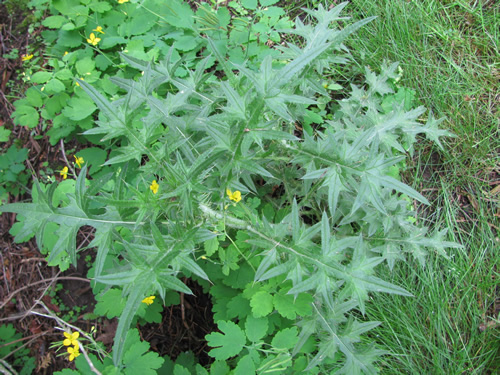
Observer: Paul Lauenstein
Observation Date: 7/15/12
Observation Time: 5:00 p.m.
Observation Location: Gavins Pond Rd. soccer field parking lot
Common Name: Bull Thistle
Scientific Name: Cirsium vulgare
Comments: The beautiful blossom of the bull thistle comes with sharp thorns.
More Information: Wikipedia
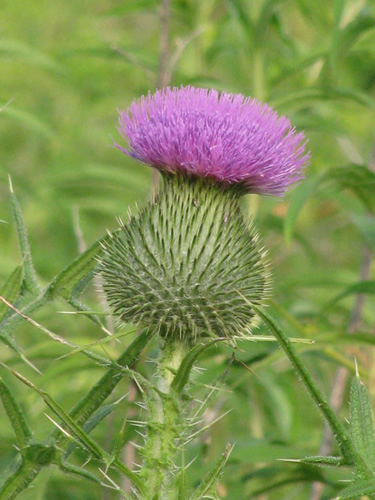
Observer: Paul Lauenstein
Observation Date: 7/7/18
Observation Time: 3:15 p.m.
Observation Location: Moose Hill Farm (TTOR)
Common Name: Butternut (White Walnut)
Scientific Name: Juglans cinerea
Comments: Butternut is a deciduous tree growing to 20 m (66 ft) tall, rarely 40 m (130 ft). Butternut is a slow-growing species, and rarely lives longer than 75 years. It has a 40–80 cm (16–31 in) stem diameter, with light gray bark.
More Information: Wikipedia and Arbor Day Foundation
Observer: Paul Lauenstein
Observation Date: 5/17/14
Observation Time: 12:55 p.m.
Observation Location: Beaver Brook near tennis courts
Common Name: Canada Mayflower
Scientific Name: Maianthemum canadense
Comments: This common plant carpets the forest floor in many parts of Sharon.
More Information: Wikipedia
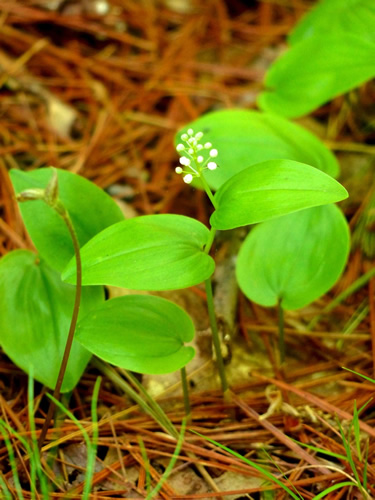
Observer: Paul Lauenstein
Observation Date: 5/27/20
Observation Time: 5:15 p.m.
Observation Location: Beaver Brook near tennis courts
Common Name: Canada Mayflower
Scientific Name: Maianthemum canadense
Comments: This common plant carpets the forest floor in many parts of Sharon.
More Information: Wikipedia
I took this photo at the same place on June 2:
Observer: Paul Lauenstein
Observation Date: 6/4/11
Observation Time: 2:40 p.m.
Observation Location: Conservation land near Billings Street
Common Name: Canada Mayflower
Scientific Name: Maianthemum canadense
Comments: Carpets the ground in many wooded areas of Sharon.
More Information: Wikipedia
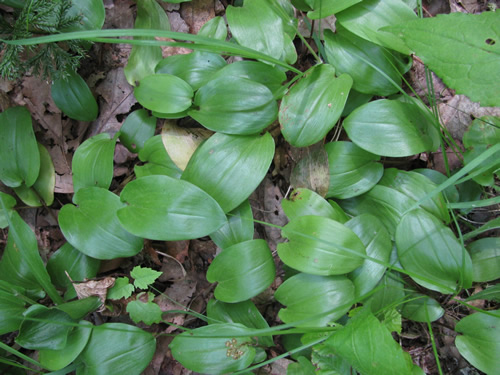
Observer: Paul Lauenstein
Observation Date: 7/12/20
Observation Time: 6:40 p.m.
Observation Location: along Gavins Pond Road
Common Name: Canada Wild Lettuce
Scientific Name: Lactuca canadensis
Comments: This edible plant can grow to over six feet tall. It has leaves that are shaped like those of a dandelion, and produces dandelion-like yellow flowers.
More Information: Wikipedia and iNaturalist
Observer: Rita Corey
Observation Date: 8/13/20
Observation Time: 3:15 p.m.
Observation Location: Morse St.
Common Name: Cardinal Flower
Scientific Name: Lobelia cardinalis
Comments: Cardinal flowers are typically found near water. These were growing in a dry streambed.
Since most insects find it difficult to navigate the long tubular flowers, cardinal flowers depend on hummingbirds, which feed on the nectar, for pollination. Its common name alludes to the bright red robes worn by Roman Catholic cardinals.
Although relatively common, overpicking this handsome wildflower has resulted in its scarcity in some areas. Please do not dig up wildflowers.
More Information: Lady Bird Johnson Wildflower Center
Observer: Paul Lauenstein
Observation Date: 6/13/20
Observation Time: 6:00 p.m.
Observation Location: Moose Hill Audubon Wildlife Sanctuary
Common Name: Carolina Allspice
Scientific Name: Calycanthus floridus
Comments: Also known as Carolina Sweetshrub, this plant deserves its name. The blossoms are fragrant and the leaves are aromatic when bruised. I wish I had encountered this plant a week earlier when the blossoms were at their prime. Maybe next year…
More Information: North Carolina Native Plant Society
Observer: Paul Lauenstein
Observation Date: 8/11/23
Observation Time: 4:45 p.m.
Observation Location: Gavins Pond Rd. (garden in my back yard)
Common Name: Carolina Horsenettle
Scientific Name: Solanum carolinense
Comments: As the name implies, the natural range of this invasive, thorny weed is the mid-Atlantic states, but it is spreading north as the climate warms.
More Information: Minnesota Wildflowers
Observer: Paul Lauenstein
Observation Date: 5/22/18
Observation Time: 10:55 a.m.
Observation Location: Moose Hill Audubon Wildlife Sanctuary
Common Name: Carolina Silverbell tree
Scientific Name: Halesia carolina
Comments: Carolina silverbell is a vigorous, fast-growing deciduous shrub or tree growing to 8 m (26 ft) tall by 10 m (33 ft) broad, bearing masses of pendent, bell-shaped white flowers which appear in spring. The flowers are followed by green, four-winged fruit. The leaves turn yellow in autumn.
Carolina silverbell grows mostly in the Piedmont and mountains of the Carolinas, eastern Tennessee, Georgia, and Alabama. Its distribution extends beyond this central area, however, in small populations scattered over the southeastern Coastal Plain, western Virginia, West Virginia, southern Ohio, southern Indiana, southern Illinois, Kentucky, Tennessee, central Arkansas, and southeastern Oklahoma. The species has been successfully cultivated as far north as southern New England, in California, and in Europe .
More Information: Wikipedia
Observer: Paul Lauenstein
Observation Date: 5/6/23
Observation Time: 10:15 a.m.
Observation Location: Moose Hill Audubon Wildlife Sanctuary
Common Name: Carolina Silverbell tree
Scientific Name: Halesia carolina
Comments: Carolina silverbell is a vigorous, fast-growing deciduous shrub or tree growing to 8 m (26 ft) tall by 10 m (33 ft) broad, bearing masses of pendent, bell-shaped white flowers which appear in spring. The flowers are followed by green, four-winged fruit. The leaves turn yellow in autumn.
Carolina silverbell grows mostly in the Piedmont and mountains of the Carolinas, eastern Tennessee, Georgia, and Alabama. Its distribution extends beyond this central area, however, in small populations scattered over the southeastern Coastal Plain, western Virginia, West Virginia, southern Ohio, southern Indiana, southern Illinois, Kentucky, Tennessee, central Arkansas, and southeastern Oklahoma. The species has been successfully cultivated as far north as southern New England, in California, and in Europe .
More Information: Wikipedia
Observer: Paul Lauenstein
Observation Date: 6/25/16
Observation Time: 1:40 p.m.
Observation Location: Maskwonicut Street near Beaver Brook
Common name: Catalpa tree
Scientific Name: Catalpa speciosa
Comments: Large, bell-shaped 2″ white flowers are borne in 4″-8″ long panicles in late spring. The very large, 6″-12″ slightly heart-shaped, leaves turn yellow-greenish or brown in fall. Bean-like seed capsules, 8″-20″ long are green in color changing to brown and splitting open when ripe.
More Information: Arbor Day Foundation
Observer: Paul Lauenstein
Observation Date: 6/13/20
Observation Time: 6:10 p.m.
Observation Location: Moose Hill Audubon Wildlife Sanctuary
Common Name: Catchweed Bedstraw
Scientific Name: Galium aparine
Comments: Native to North America and Eurasia, this weed is an annual broadleaf plant with a shallow, branching taproot. The stems of catchweed bedstraw are square in cross-section, weak, mostly unbranched, and grow to about 6 feet long, but are unable to stand on their own, so they often clamber over upright plant species.
Catchweed bedstraw, also known as Stickywilly, Cleaverwort, White Hedge, Goosegrass, Gripgrass, Scarthgrass, and Velcro Plant, remains low and sprawling, forming dense, tangled mats. Hairlike bristles cover the stems and leaves of the plant; these bristly hairs are responsible for its characteristic tangled growth habit and the “sticky” way it clings to clothing and animals.
Historically used as an herbal remedy for various ailments, its dried and roasted fruits have also been used to make a coffee substitute (in fact, the plant is in the same family as coffee, Coffea spp).
More Information: Washington State University
Observer: Paul Lauenstein
Observation Date: 6/14/09
Observation Time: 11:30 a.m.
Observation Location: Moose Hill Farm, Trustees of Reservations land
Common Name: Celandine
Scientific Name: Chelidonium majus
More Information: Flora Health Herb Encyclopedia
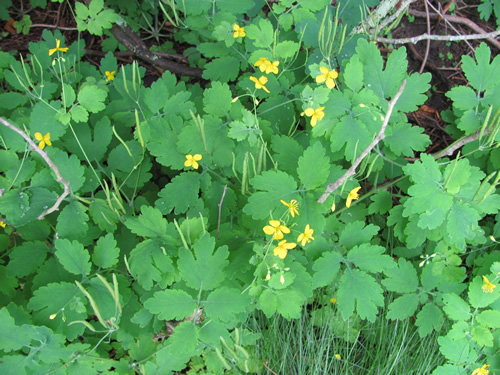
Observer: Paul Lauenstein
Observation Date: 9/7/20
Observation Time: 5:40 p.m.
Observation Location: conservation land near Lakeview & Morse
Common Name: Chicken of the Woods
Scientific Name: Laetiporus sulphureus
Comments: These relatively small specimens were growing on a dead oak tree. Chicken of the Woods can grow to very large size. They are edible, but it is wise to refrain from eating any wild-harvested food unless you are absolutely sure it is not poisonous. As the saying goes, everything is edible – at least once!
More Information: Wikipedia
Observer: Paul Lauenstein
Observation Date: 6/27/15
Observation Time: 2:45 p.m.
Observation Location: Gavins Pond Road near soccer fields
Common Name: Chicory
Scientific Name: Cichorium intybus
Comments: A perennial herb with blue, lavender, or occasionally white flowers, chicory grows as a wild plant on roadsides in its native Europe, and in North America and Australia, where it has become naturalized. Common chicory is also known as blue sailors, succory, and coffeeweed.
More Information: Wikipedia
Observer: Paul Lauenstein
Observation Date: 7/7/10
Observation Time: 7:05 a.m.
Observation Location: Gavins Pond Road near soccer fields
Common Name: Chicory
Scientific Name: Cichorium intybus
Comments: A perennial herb with blue, lavender, or occasionally white flowers, chicory grows as a wild plant on roadsides in its native Europe, and in North America and Australia, where it has become naturalized. Common chicory is also known as blue sailors, succory, and coffeeweed.
More Information: Wikipedia

Observer: Kathy Farrell
Observation Date: 10/31/18
Observation Time: N/A
Observation Location: Off Mountain Street, off Bay Rd.
Common Name: Evergreen Fern, or Christmas Fern
Scientific Name: Polystichum acrostichoides
Comments: One of the commonest ferns in eastern North America, being found in moist and shady habitats in woodlands, rocky slopes, and stream banks. The common name derives from the evergreen fronds which are often still green at Christmas in December.
More information: Wikipedia
Observer: Paul Lauenstein
Observation Date: 5/22/18
Observation Time: 9:40 a.m.
Observation Location: Town conservation land near Beaver Brook
Common Name: Cinnamon Fern
Scientific Name: Osmundastrum cinnamomeum
Comments: The Osmundastrum cinnamomeum fern forms huge clonal colonies in swampy areas. These ferns form massive rootstocks with densely matted, wiry roots. This root mass is an excellent substrate for many epiphytal plants. They are often harvested as osmunda fiber and used horticulturally, especially in propagating and growing orchids. Cinnamon Ferns do not actually produce cinnamon; they are named for the color of the fertile fronds.
More Information: Wikipedia
Observer: Paul Lauenstein
Observation Date: 4/27/24
Observation Time: 4:10 p.m.
Observation Location: Moose Hill Farm (The Trustees of Reservations)
Common Name: Common Blue Violet
Scientific Name: Viola sororia
Comments: The blossoms of common blue violets come in colors ranging from white to purple. The two plants shown in the photos were growing a few feet from each other.
More information: Wild Edible
The pasture at Moose Hill Farm near the spot where these violets were growing:
Observer: Paul Lauenstein
Observation Date: 5/5/18
Observation Time: 8:00 a.m.
Observation Location: Moose Hill Audubon Wildlife Sanctuary
Common Name: Common Blue Violet
Scientific Name: Viola sororia
Comments: For information, see: http://thebotanicalhiker.blogspot.com/2015/04/eating-wild-identifying-wild-edible.html
Observer: Paul Lauenstein
Observation Date: 5/7/23
Observation Time: 6:25 a.m.
Observation Location: Moose Hill Audubon Wildlife Sanctuary
Common Name: Common Blue Violet
Scientific Name: Viola sororia
Comments: These were growing along the driveway leading into the parking lot. Please do not dig up wildflowers.
More information: The Botanical Hiker
Observer: Paul Lauenstein
Observation Date: 5/16/23
Observation Time: 3:40 p.m.
Observation Location: Moose Hill Audubon Wildlife Sanctuary
Common Name: Common Buttercup
Scientific Name: Ranunculus acris
Comments: The Common Buttercup (Ranunculus acris); also called Tall Buttercup, Meadow Buttercup and Blister Plant; is a perennial forb/herb in the Ranunculaceae family. The family and genus names come from the Latin for “little frog” because this family prefers wet areas. It’s also called Tall Crowfoot because of the irregular shape of the leaves. The species name is from the Latin for “bad tasting,” that is, acrid. This plant has a very acrid fluid (glycoside ranunculin) that discourages foraging by animals.
More Information: French Hill Pond Field Plants and Go Botany
